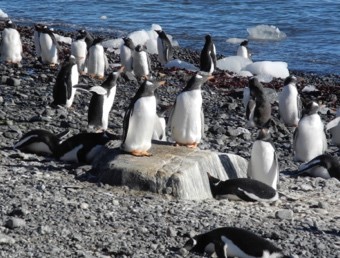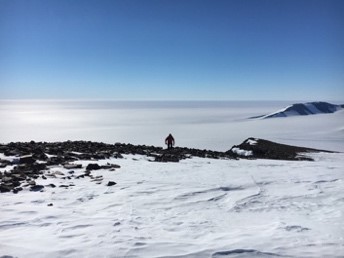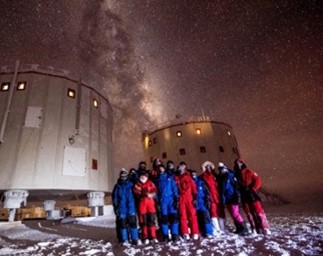Canada and the Antarctic
Table of Contents
About Antarctica
Antarctica, Earth's southernmost continent, is a place of extremes. Over 99% of Antarctica is covered in ice, which is up to 4.9 km thick inland, and extends over the sea in the form of ice shelves along the coast. Antarctica has some of the world's most severe weather, with average temperatures that range from -10°C to -60°C, and an arid interior where violent winds are the norm. In these conditions ecosystems are sparse, but some creatures do manage to eke out a living there. The largest terrestrial animal native to Antarctica is the tiny springtail, also known as the snow-flea. A dozen of them would fit on your fingernail.
The greater Antarctic region also encompasses the Southern Ocean and islands south of the 60th parallel. In contrast to the Antarctic continent, the marine environments in this area are some of the most biologically productive waters in the world. Thanks to its strong currents and upwelling of deep, cold waters, the Southern Ocean teems with nutrients and supports a great abundance of life, from microscopic algae to krill, fish, seals, whales, sea birds, and more.
Antarctica has no native human populations. Māori and Polynesian explorers are believed to have been amongst the first to sight and potentially visit Antarctica in seventh century with Western documented exploration beginning in the 1800's. Humans continue to visit the Antarctic to explore, research and document the polar environment, as well as participate in the whaling and sealing industry.
In 1957-1958 the International Geophysical Year, a major coordinated international research effort, demonstrated the benefits of international science cooperation in Antarctica. This led to development of the Antarctic Treaty, signed in 1959 by twelve countries. The Treaty establishes and enforces a set of common obligations for nations operating in the region. Most importantly, the Treaty dedicates the Antarctic to peace and science, and restricts military and industrial activity. Since its original signing, the Antarctic Treaty has grown into a treaty system which includes the Protocol on Environmental Protection to the Antarctic Treaty, the Convention for the Conservation of Antarctic Seals, and the Convention on the Conservation of Antarctic Marine Living Resources as related agreements. Over 50 countries currently participate in the Antarctic Treaty System.
Why the Antarctic matters
While the Antarctic, and especially the continent of Antarctica, is one of the most remote places on Earth, the environmental conditions in this region influence global ocean and climate systems. Most notably, the Antarctic Circumpolar Current is the primary means for exchange of water and heat between ocean basins, and the Southern Ocean is a major sink of the carbon dioxide emitted by human activities. Understanding these influences and changes over time is important for predicting global climatic trends. Also, ocean currents carry nutrients from the Southern Ocean to marine ecosystems around the world, fueling global biological productivity—and therefore supporting fisheries. Above Antarctica, in the stratosphere, human-caused emissions of ozone depleting substances drove the formation of the ozone hole, a phenomenon first identified in Antarctic field measurements. Thanks to the Montreal Protocol and its amendments, the ozone hole is now recovering, though it continues to influence the climate of the Southern Hemisphere.
Global climate change is bringing rapid transformation to Antarctic and Southern Ocean environments. The Antarctic peninsula is among the most rapidly warming regions on Earth. Antarctica's ice sheets are losing mass to the ocean at an accelerating rate, with implications for global sea level and marine life, and consequences for the resilience of coastal communities and infrastructure. These changes can only be understood through research and modelling. By studying and understanding the changes taking place in Antarctica, researchers are gaining new knowledge that is relevant to all of the regions of the world.
For Canada, research in the Antarctic also provides valuable comparative information relevant to the Arctic, given the extreme cold and remote environments of both regions. This includes:
- developing and using cold climate technology, environmental monitoring techniques and other related infrastructure;
- conducting research into persistent organic pollutants, invasive species, and geological and glaciological processes, and the effects of climate warming on permafrost and the cryosphere;
- understanding the economic and environmental impacts of cruise ship tourism in the polar regions.
Antarctica also provides a remote, environmentally extreme platform for the following:
- studying the effects of isolation, confinement, remoteness, and extreme environmental conditions on cognition, emotion, social relations, and other variables relevant to a wide variety of human habitats, and
- observing outer space and the near-space environment.
Research is also being conducted—particularly by the Scientific Committee on Antarctic Research's Humanities and Social Science Expert Group—on the history and archaeology of Antarctic exploration and industry, such as fishing and whaling, as well as international relations in the Antarctic.
Canadian Antarctic research
Scientific research has always been, and continues to be, the main source of activity and collaboration on the Antarctic continent. While the Antarctic Treaty System has grown substantially since its original signing in 1959 and entry into force in 1961, countries that have subsequently become full consultative members to the Treaty have been required to demonstrate meaningful and sustained contributions to Antarctic research.
Canadians have been involved in Antarctic research for more than a century, and the map of Antarctica reflects this: over 100 of the continent's place names have a Canadian connection. Canadian Antarctic researchers are based at more than 20 different Canadian universities and six federal government organizations. As Canada is an Arctic state with strong and growing capabilities in cold-climate research, Canadian researchers have the necessary knowledge and tools to make substantial contributions to polar science in both the Arctic and Antarctic. Canada's contribution to refereed Antarctic scientific literature has grown over the past two decades (Figure 1) and typically amounts to dozens of papers per year with a Canadian author or co-author.

Figure 1: Web of Science (WoS) was searched in September 2024 with a detailed query that generated a list of all Canada-affiliated Antarctic research publications for the period of 2021- 2024. These publications were manually reviewed to verify that all were relevant to the Antarctic Treaty area. These results were combined with earlier Canadian bibliographies, which date back as far as 1997.
Research themes
Primarily in partnership with the national Antarctic programs of other countries, Canadians conduct modelling and field research in a broad range of disciplines, including life sciences, physical sciences, geosciences, and human and social sciences. Canadians have also developed cold-weather technology that facilitates and supports Antarctic science, and Canadian companies are long-standing providers of Antarctic research logistics.
Canadian researchers serve in and contribute to the following groups at the Scientific Committee on Antarctic Research:
- Geosciences
- Physical Science
- Life Sciences
- Astronomy and Astrophysics from Antarctica
- Scientific Research Programmes
- Programme Planning Groups
Click on the following links to explore recent Canadian contributions to Antarctic research.
-

Photo: John Crump
-

Photo: Diana Varela
-

Photo: Ian Hogg
-

Photo: ESA, B. Healey
Funding Canadian Antarctic research
Understanding the Antarctic's vast and diverse range of environments and processes is an international challenge that requires substantial financial, logistical and human resources. While Canada does not have an Antarctic research station, it funds Canadian Antarctic research efforts through a bottom-up, researcher-driven approach. Canadian Antarctic researchers apply for funding through existing calls at Canada's relevant granting councils.
Notably, total support for Antarctic research by the Natural Sciences and Engineering Research Council of Canada (NSERC) has increased steadily in the last decade (see Figure 2). NSERC supported 91 Canadian research leads, funding 113 Antarctic research projects from 2008-2023, for a total of $13.64M. The Canadian Space Agency has also made significant contributions to, and funding for, Antarctic research.
Most Canadian Antarctic researchers collaborate with international partners to conduct Antarctic research, particularly if field work and access to Antarctic research infrastructure is required. Canadian researchers collaborate most often with United States-based researchers and also regularly partner with research teams from the United Kingdom, Australia, Germany, South Korea, Spain, USA, New Zealand, Chile and France, among others.

Total NSERC funding for Antarctic research to support Canadian Antarctic research programs from 2008 to 2023. The trend in funding support has risen since 2008 where total funding was around $500,000 in total to 2023 where funding is roughly $1,200,000. Source: NSERC's Awards Database - Natural Sciences and Engineering Research Council of Canada
Polar Knowledge Canada's Antarctic mandate
Polar Knowledge Canada (POLAR) is Canada's lead federal agency to strengthen Canadian leadership in polar science and technology. POLAR's Antarctic mandate is established in POLAR's enabling legislation, the Canadian High Arctic Research Station Act. Along with other Government of Canada departments, POLAR participates in the annual Antarctic Treaty Consultative Meeting (ATCM) and meeting of the Committee for Environmental Protection (CEP). As a non-consultative party, Canada can participate in Antarctic governance discussions, but cannot vote on decisions.
POLAR is working with other government departments to strengthen support for Canadian Antarctic research. These efforts include opportunities to partner with the national polar programs of other countries, to facilitate Canadian access to existing Antarctic research infrastructure and logistics. From 1994 to 2012, the Canadian Polar Commission published regular newsletters for the Canadian Antarctic Research Network. In 2016, POLAR hosted the Canadian Antarctic Research Workshop in Ottawa to engage with the Canadian Antarctic research community and explore opportunities to strengthen Canadian research activities in the region. The Canadian Antarctic Research Workshop Report outlines existing Canadian research interests in Antarctic and potential funding scenarios for future Antarctic programs. In December 2022, a second workshop was held in Cambridge Bay, Nunavut, to update the core research themes of Canada's Antarctic Research Program.
For more details on POLAR's Antarctic mandate and activities, watch this video (12min). Canada Application for COMNAP Membership.
Canadian Committee on Antarctic Research (CCAR)
POLAR's Canadian Committee on Antarctic Research (CCAR) provides advice and guidance to POLAR on Antarctic matters including opportunities to strengthen Canadian Antarctic research activities, and serves as Canada's National Committee under the Scientific Committee on Antarctic Research (SCAR). CCAR members are appointed by POLAR through consultation with the Committee itself and other interested parties to ensure nominees represent the full scope of Canadian involvement in Antarctica.
Canadian Antarctic Research Program
Under its Antarctic mandate, POLAR has engaged with key partners and researchers to develop the framework for a Canadian Antarctic Research Program to better coordinate, increase and expand Canadian Antarctic research to provide a more comprehensive understanding of the Antarctic region, global systems, and polar linkages. This program will operate primarily through partnerships with the national polar programs of other countries to facilitate Canadian access to existing Antarctic research infrastructure and logistics. POLAR's Canadian Committee on Antarctic Research (CCAR) provides advice and guidance to POLAR on Antarctic matters.
The Scientific Committee on Antarctic Research (SCAR)
POLAR is Canada's adhering body to the Scientific Committee on Antarctic Research (SCAR), which initiates, develops and coordinates international scientific research in the Antarctic and Southern Ocean and provides scientific advice to the United Nations Framework Convention on Climate Change and the Intergovernmental Panel on Climate Change. POLAR appoints representatives to serve on SCAR's Standing Scientific Groups and Committees on behalf of Canada.
For more information, please visit the following webpages:
Council of Managers of National Antarctic Programs (COMNAP)
Canada (via POLAR) is a member of the Council of Managers of National Antarctic Programs (COMNAP), which serves as an international forum to develop practices that improve the effectiveness of activities in the Antarctic in an environmentally responsible manner, and facilitates related information exchange and international partnerships.
As the operator of the Canadian High Arctic Research Station (CHARS) in Cambridge Bay, Nunavut, POLAR also engages with the COMNAP community for knowledge-sharing opportunities with other polar research stations. While operating Arctic and Antarctic research infrastructure presents many similar challenges, there is also potential for countries to better coordinate and leverage polar research infrastructure to advance scientific objectives.
Resources for Antarctic researchers
The following resources are available for Antarctic researchers.
Antarctic resources
| Name | Description |
|---|---|
| The Antarctic Treaty | Establishes Antarctica as a place for peaceful and scientific purposes. |
| The Protocol on Environmental Protection to the Antarctic Treaty | Designates Antarctica as a natural reserve, devoted to peace and science. |
| Antarctic Environmental Protection Act | Canada's Act to protect the Antarctic environment, which serves as the legislative basis the Canada requires to oversee Canadian activities in the Antarctic and fulfill the obligations of the Protocol on Environmental Protection to the Antarctic Treaty. |
| Antarctic Environmental Protection Act Permits | Provides information on how to apply for a permit from Environment and Climate Change Canada to undertake activities in the Antarctic. |
| Council of Managers of National Antarctic Programs (COMNAP) | The international association that brings together national Antarctic programs to develop and promote best practices in managing the support of scientific research in Antarctica. |
| The Scientific Committee on Antarctic Research (SCAR) | Initiates, promotes and coordinates scientific research in Antarctica and the Southern Ocean and provides international, independent scientific advice to the Antarctic Treaty system and other bodies |
| Antarctic Environments Portal | Makes science-based information available to the Antarctic Treaty System and all Antarctic Treaty nations. |
| Quantarctica | A free geographic information system package for Antarctica. |
| Southern Ocean Observing System (SOOS) | An international initiative that aims to facilitate the collection and delivery of essential observations on dynamics and change of Southern Ocean systems to all international stakeholders through design, advocacy and implementation of cost-effective observing and data delivery systems. |
| Commission for the Conservation of Antarctic Marine Living Resources (CCAMLR) | Established by international convention with the objective of conserving Antarctic marine life. |
| International Association of Antarctica Tour Operators (IAATO) | Advocates and promotes the practice of safe and environmentally responsible private-sector travel to the Antarctic |
| Association of Polar Early Career Scientists (APECS) | Creates opportunities for the development of innovative, international, and interdisciplinary collaborations among current early career polar researchers. |
| Polar Data Catalogue (PDC) | A database of metadata and data that describes, indexes, and provides access to diverse data sets generated by Arctic and Antarctic researchers. |